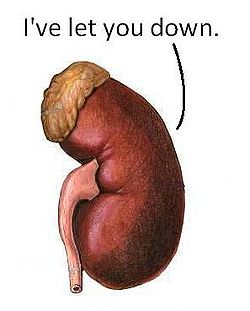Acute kidney injury: Difference between revisions
Kingrajinix (talk | contribs) |
Kingrajinix (talk | contribs) (→Bloods) |
||
| (11 intermediate revisions by 2 users not shown) | |||
| Line 1: | Line 1: | ||
[[image: | [[image:kidneyfailure.jpg|right|thumb|250px]] | ||
===Definition=== | ===Definition=== | ||
Acute (over hours and days) deterioration of kidney function. This measured by serum urea and creatinine, often accompanied by oliguria and anuria. | Acute (over hours and days) deterioration of kidney function. This measured by serum urea and creatinine, often accompanied by oliguria and anuria<ref>Oxford Handbook of Clinical Medicine by M Longmore, et al 8th Edition - Acute Renal Failure: page 298</ref>. | ||
===Epidemiology=== | ===Epidemiology=== | ||
[[image:common.jpg]] | [[image:common.jpg]] | ||
| Line 11: | Line 11: | ||
*Obstruction | *Obstruction | ||
*Others: hepatorenal syndrome, [[vasculitis]] | *Others: hepatorenal syndrome, [[vasculitis]] | ||
===Clinical Features=== | ===Clinical Features=== | ||
Very much depends on cause but [[oliguria]] and [[anuria]] are both signs of acute renal failure. | Very much depends on cause but [[oliguria]] and [[anuria]] are both signs of acute renal failure. | ||
===Investigations=== | ===Investigations=== | ||
====Bloods==== | |||
*'''[[U+E]]''' - '''creatinine''' and '''urea''', particularly '''creatinine clearance'''. However, it can be an inaccurate measure of GFR. Also keep an eye out for any [[electrolyte disturbance]]. | *'''[[U+E]]''' - '''creatinine''' and '''urea''', particularly '''creatinine clearance'''. However, it can be an inaccurate measure of GFR. Also keep an eye out for any [[electrolyte disturbance]]. | ||
*[[FBC]] - for [[infection]] | |||
*[[CRP]] - marker of [[infection]] | |||
*[[Bicarbonate]] - to rule out [[acidosis]] | |||
*[[ABG]] - to look for [[metabolic acidosis]] | |||
*Blood cultures (if the patient has a [[raised temperature]]) | |||
Other bloods could include: [[INR]] (hepatorenal syndrome), [[ESR]] (acute nephritis), [[LFT]] (hepatorenal syndrome), [[CK]], [[LDH]] (marker of tissue breakdown), Protein electrophoresis, hepatitis serology, auto-antibodies | |||
====Urine==== | |||
Send for microscopy and cultures. | |||
====Imaging==== | |||
*[[USS]] of renal tract | |||
*[[ECG]] | |||
*[[CXR]] | |||
===Management=== | ===Management=== | ||
====Acute==== | |||
*'''Catherise''' for 24h urine | |||
*Do '''fluid chart''' | |||
*Consider a [[central venous line]] | |||
*'''Treat [[hyperkalaemia]]''' which commonly occurs | |||
*If [[dehydrated]] | |||
**'''fluid challenge''' of '''250-500ml''', either colloid or 0.9% saline over '''30min''' | |||
**Repeat and aim for [[CVP]] of 5-10cm | |||
*If fluid overload | |||
**Nitrate infusion, furosemide or dopamine ('renal dose') | |||
**Consider dialysis | |||
*[[Acidosis]] | |||
**give sodium bicarbonate 50ml 8.4% iv | |||
*Suspicion of [[sepsis]] - cultures and antibiotics | |||
Avoid nephrotoxic drugs (NSAIDS and be careful with [[gentamicin]]) | |||
====Underlying principles==== | |||
Basically, you need to '''treat the cause''' first and foremost (so the kidneys stop failing) and '''treat hyperkalaemia''' (that makes them go intoo [[VF]] which is a whole world of rubbishness). [[Pulmonary oedema]], [[pericarditis]] and [[tamponade]] are further life-threatning differentials which need to be considered followwed by treating [[dehydration|volume depletion]] and [[sepsis]]. | |||
===Prognosis=== | ===Prognosis=== | ||
About 60% of patients with ARF die, and approximately 10% of survivors go on to needing dialysis<ref>"The epidemiology of acute renal failure in the world." by S Uchino - Curr Opin Crit Care. 2006 Dec;12(6):538-43.</ref>. | |||
{{reflist}} | |||
Latest revision as of 21:57, 12 July 2011
Definition
Acute (over hours and days) deterioration of kidney function. This measured by serum urea and creatinine, often accompanied by oliguria and anuria[1].
Epidemiology
Pathophysiology
There are lots of causes of acute renal failure:
- Hypovolaemia
- Sepsis
- Reduced cardiac output
- Obstruction
- Others: hepatorenal syndrome, vasculitis
Clinical Features
Very much depends on cause but oliguria and anuria are both signs of acute renal failure.
Investigations
Bloods
- U+E - creatinine and urea, particularly creatinine clearance. However, it can be an inaccurate measure of GFR. Also keep an eye out for any electrolyte disturbance.
- FBC - for infection
- CRP - marker of infection
- Bicarbonate - to rule out acidosis
- ABG - to look for metabolic acidosis
- Blood cultures (if the patient has a raised temperature)
Other bloods could include: INR (hepatorenal syndrome), ESR (acute nephritis), LFT (hepatorenal syndrome), CK, LDH (marker of tissue breakdown), Protein electrophoresis, hepatitis serology, auto-antibodies
Urine
Send for microscopy and cultures.
Imaging
Management
Acute
- Catherise for 24h urine
- Do fluid chart
- Consider a central venous line
- Treat hyperkalaemia which commonly occurs
- If dehydrated
- fluid challenge of 250-500ml, either colloid or 0.9% saline over 30min
- Repeat and aim for CVP of 5-10cm
- If fluid overload
- Nitrate infusion, furosemide or dopamine ('renal dose')
- Consider dialysis
- Acidosis
- give sodium bicarbonate 50ml 8.4% iv
- Suspicion of sepsis - cultures and antibiotics
Avoid nephrotoxic drugs (NSAIDS and be careful with gentamicin)
Underlying principles
Basically, you need to treat the cause first and foremost (so the kidneys stop failing) and treat hyperkalaemia (that makes them go intoo VF which is a whole world of rubbishness). Pulmonary oedema, pericarditis and tamponade are further life-threatning differentials which need to be considered followwed by treating volume depletion and sepsis.
Prognosis
About 60% of patients with ARF die, and approximately 10% of survivors go on to needing dialysis[2].
